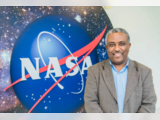Summer of SaSa
The Students Airborne Science Activation (SaSa) began its inaugural year in 2022. In Kiswahili, sasa means "now"; as a mission, SaSa means research experiences for 25 students from MSIs. It has four main objectives, the fourth being "to provide research, mentoring, and networking opportunities for early-career undergraduates to address the shortage of individuals from historically underrepresented groups graduating with STEM degrees from Minority Serving Institutions (MSIs) and a need to prepare these students to enter STEM graduate programs as well as the NASA and research workforce." Students from MSI partners Howard University, University of Maryland, Baltimore County (UMBC), Coppin State University, Morgan State University, University of Maryland Eastern Shore and Hampton University are participating in the first SaSa class. To learn more about SaSa's objectives and opportunities, visit https://www.nasa.gov/welcome-to-sasa as well as https://www.youtube.com/watch?v=mFRIA_C-l2c.
In January 2021, NASA selected nine proposals for funding as part of its "next phase of Science Activation to connect NASA science with learners of all ages." Among those awarded was Student Airborne Science Activation for MSI (SaSa), PI: Charles Gatebe, Atmospheric Science Branch Chief, NASA Ames Research Center, Moffet Field, CA: "The SaSa project will work to address minority representation in geosciences (comprised of ocean, atmosphere, and Earth sciences) by engaging students through NASA-related airborne campaigns." (Check out Dr. Gatebe's interview with Storycorps.org.) At UMBC, Ruben Delgado, Assistant Research Professor with GESTAR II and UMBC's Physics Department, and Belay Demoz, Director of GESTAR II and Professor in UMBC's Physics Department, are both Co-PIs on SaSa. Additionally, of SaSa's five Graduate Student Mentors, Emily Faber, Kylie Hoffman, and Maurice Roots are pursuing their doctoral degrees at UMBC in Atmospheric Physics. Alicia Hoffman, a third-year Ph.D. student at the University of Wisconsin-Madison, and David Moore, a first-year Ph.D. student at UCLA, are the other two mentors. Meet the 2022 SaSa class here.
The first part of the summer of SaSa brought students to UMBC for a two-week introductory summer workshop plus hands-on training at Hampton University. While at UMBC, they met with UMBC President Freeman Hrabowski, who presented an inspiring talk. Presently, during the second part of the program, the students are immersed in a research field campaign. As reported in several media outlets, a NASA P3 from Wallops Flight Facility is being used for SaSa to "conduct atmospheric studies over DC to Baltimore" (see photo below). The third step will be to process and analyze the data and present the research results. This invaluable experience provides insight to what is involved in being a research scientist as well as the opportunity to develop analytical, collaboration and presentation skills.
Make note of these upcoming dates! On Thursday, July 14, WRC-DC, the NBC4 channel in Washington, DC, aired a story on SaSa during its newscasts in the morning (4 a.m., 5 a.m., 6 a.m., and 11 a.m.) and the afternoon. Additionally, for those who are onsite at NASA Goddard Space Flight Center, on Friday, July 29, there will be a Student Airborne Science Activation (SaSa) Internship Poster Showcase in the NASA GSFC Building 33 lobby from 11:00 a.m. - 12:30 p.m. Please stop by and talk with the students.
Be sure to bookmark and revisit https://www.nasa.gov/sasa for the ongoing events and accomplishments of this exciting mission and to follow the students' experiences.
SaSa students in front of P-3 aircraft at Wallops. Photo provided by B. Demoz.
Posted: July 11, 2022, 3:51 PM
